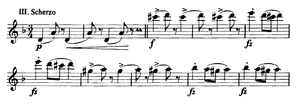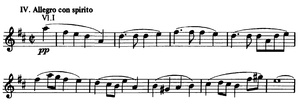6th symphony (Dvořák)
The Symphony no. 6 D-Op. 60 is a symphony of Dvořák . It was published as the composer's 1st symphony during the composer's lifetime. Like its predecessor, the symphony is characterized by strong Bohemian and Czech influences in its musical theme. The work is dedicated to the conductor Hans Richter .
Emergence
Dvořák's 6th Symphony was written in 1880, about five years after completing his 5th symphony . Nevertheless, there are content-related parallels in both works, which have a very pastoral and bohemian-national sound. This period in Dvořák's life was marked by the slow international breakthrough and the finding and development of his personal compositional style, which he had already developed to a very large extent by the completion of the 6th Symphony.
Dvořák wrote the work for the Vienna Philharmonic and its chief conductor Hans Richter. Shortly before the planned premiere in December 1880, it was canceled due to Richter's illness and overcrowding in the orchestra. However, Dvořák suspected anti-Czech attitudes in Vienna at the time as the real reason for the rejection. Instead, on March 25, 1881, the symphony was premiered in Prague under Adolf Čech, who had already directed the world premiere of the 5th symphony. Richter first performed the symphony in London in 1892 .
To the music
occupation
2 flutes (2nd also piccolo ), 2 oboes , 2 clarinets , 2 bassoons , 4 horns , 2 trumpets , 3 trombones , tuba , timpani and strings .
1st movement: Allegro non tanto
The first movement begins with a subdued theme of flute and cello. Its three-part structure contains all the important motivic building blocks for the overall conception of the movement, which is in sonata form . This theme will be expanded and taken up by the whole orchestra and worked on in detail. A second theme in B minor (derived from y and z) is led to major and finally performed cheerfully by the whole orchestra.
The subsequent implementation brings a retarding element and the minor version of the main theme. In the further course there are fugato elements, which are derived from the second theme. The strings then introduce the recapitulation with a structure of dynamically rising quarter notes , which runs properly. The final coda takes up both themes and also processes the string quarters, which had previously led to the recapitulation. The action is brought to an apparent piano conclusion before the orchestral tutti throws in the final chords.
2nd movement: Adagio
The Adagio in B flat major begins with a lyrical melody in the woodwinds, which is soon continued by the strings and horns. A peaceful and calm mood is conveyed. The movement combines the rondo and the variation movement . An ABACABA form brings the main theme (A) back in a slightly varied manner. With a shocking drama, the C-theme breaks in dark and throbbing minor chords over the calm, flowing events. The return of the main theme then occurs only tentatively in the flutes before it is slowly taken up again by the orchestra. The last repetition is introduced by the softly throbbing kettledrum, which lets the movement fade away after a final climax.
3rd movement: Scherzo. Furiant
The Scherzo of the 6th Symphony is a furious one . This somewhat rough Czech dance is characterized by the change in time from 2/4 and 3/4 time. Dvořák had already used this Bohemian national dance, for example, in the Slavonic Dances op.46 . The two-part Furiant theme combines a crude and somewhat awkward-looking phrase with a graceful, dance-like motif. The trio differs significantly from the Furiant in character and places a pastoral flute melody in the foreground.
4th movement: Finale. Allegro con spirito
The main theme of the finale is reminiscent of the style of the 2nd symphony by Johannes Brahms , Dvořák's friend, which was composed two years earlier. The second theme complements the calm flowing main theme with erratic and lively elements. This second topic is moved to minor in the development and processed in a variety of ways. The coda leads the symphony to a fortissimo conclusion, in which the main theme is presented with enlarged note values.
effect
The first performance of the 6th symphony was a great success for Dvořák. The Czechs received the new symphony more positively than any other work by Dvořák so far. This was mainly due to the fact that the symphony has a very national character and thus satisfied the desire of Dvořák's Czech compatriots for their own style. He had previously been criticized for not thinking and composing nationalistically enough. A point of criticism that from today's point of view hardly seems understandable, since Dvořák's music today seems mostly Bohemian and quite nationally conscious.
The symphony quickly caught on in the rest of Europe and was performed frequently. Only in Vienna did the symphony have a difficult time. The political climate at that time placed great emphasis on German culture and the German style, which is why Dvořák's 6th symphony was not heard for the first time in Vienna until 1883.
The 6th symphony is now considered one of Dvořák's most nationally conscious works and is artistically on the threshold of the great and most important symphonies of the master ( 7th , 8th and 9th symphonies ). Even today it is still very popular and is performed frequently.
Individual evidence
- ^ Antonín Dvořák, Symphony no.6, op. 60 in D major , (New York: Edition Eulenburg, n. D.), Miniature score, 1-2.
literature
- Hansjürgen Schaefer: Concert book for orchestral music A – F. VEB German publishing house for music, Leipzig 1958.
- Alfred Beaujean in: Lexicon Orchestermusik Romantik , ed. von Wulf Konold, Munich: Piper 1989, Vol. 1, pp. 199-201
- Harenberg concert guide. Harenberg Kommunikation, Dortmund 1998, ISBN 3-611-00535-5 .
Web links
- 6th Symphony (Dvořák) : Sheet music and audio files in the International Music Score Library Project




